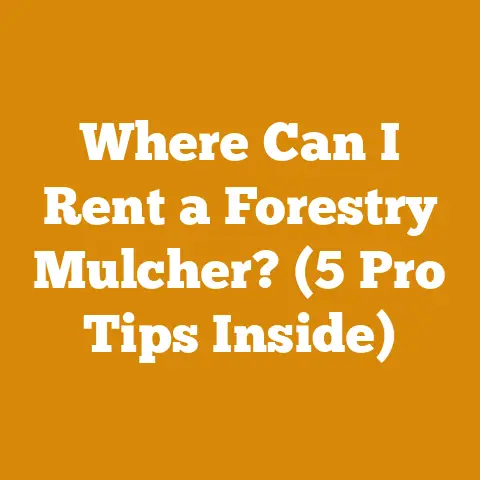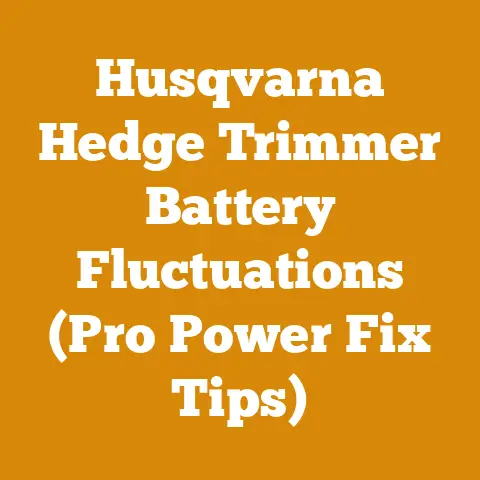How to Get Rid of Hornet Nest in Ground (5 Safe Woodshop Hacks)
Here’s how to get rid of a hornet nest in the ground, focusing on quick, safe, and effective solutions that even integrate with a woodshop mindset:
I understand the urgency.
Discovering a hornet nest in the ground is never a pleasant surprise, especially near a woodshop where you’re constantly moving around.
Those little stingers pack a punch, and disturbing their home can lead to a painful encounter.
Over the years, I’ve had my share of close calls—from accidentally kicking over a yellowjacket nest while splitting logs to finding wasps had built a fortress in a stack of drying lumber.
Trust me, I get it.
You want them gone, and you want them gone now.
While this article is about hornets, a lot of these techniques can be applied to other ground-nesting pests like yellowjackets.
The key is understanding their behavior and using the right tools and strategies.
Understanding the Enemy: Hornet Behavior and Identification
Before we dive into the “how,” let’s talk about the “who.” Hornets are aggressive insects, and unlike bees, they can sting repeatedly.
Identifying them correctly is crucial.
They are typically larger than wasps, with black and white or yellow markings.
Their nests are often found in the ground, but they can also be located in hollow trees, sheds, or even within walls.
- Key Identifiers: Large size (up to 1.5 inches), black and white/yellow markings, aggressive behavior, large paper nests.
- Nesting Habits: Underground, hollow trees, sheds, walls.
- Peak Activity: Late summer and early fall, when colonies are largest.
Understanding their behavior is just as important.
Hornets are most active during the day, foraging for food.
They are highly protective of their nest and will attack anything they perceive as a threat.
This is why it’s crucial to approach the situation with caution and a well-thought-out plan.
5 Safe Woodshop Hacks to Evict Your Unwanted Guests
Here are five methods I’ve found effective for dealing with ground hornet nests, keeping woodshop safety in mind.
These methods prioritize safety and minimizing harm to the environment.
1. The Night Raid: Dusting with Insecticide
Why it works: Hornets are less active at night.
This gives you a window of opportunity to approach the nest with minimal risk.
How to do it:
- Gear Up: This is paramount.
Wear long sleeves, pants, gloves, eye protection, and a bee veil or hooded jacket.
Duct tape the cuffs of your sleeves and pants to your gloves and boots to prevent hornets from crawling inside. - Choose Your Weapon: Use an insecticide dust specifically labeled for wasps and hornets.
These dusts are designed to be carried back into the nest by the insects, effectively poisoning the entire colony.
I’ve had good luck with products containing carbaryl or permethrin. - Timing is Everything: Wait until after dark, preferably on a cool night.
Hornets are sluggish in the cold. - The Approach: Using a duster (you can often find these at garden supply stores), puff the insecticide dust directly into the nest entrance.
Don’t be shy; apply a generous amount. - The Retreat: After applying the dust, retreat quickly and quietly.
Monitor the nest entrance over the next few days.
You should see a decrease in activity. - Repeat if Necessary: If you still see hornets after a week, repeat the treatment.
Woodshop Integration:
- Keep insecticide dust readily available in your woodshop.
- Store protective gear in an easily accessible location.
- Establish a clear “no-go zone” around the nest to prevent accidental disturbance.
Safety Considerations:
- Always read and follow the instructions on the insecticide label.
- Avoid applying insecticide on windy days to prevent drift.
- Keep children and pets away from the treated area.
Personal Story: I once had a massive hornet nest under a pile of old pallets behind my woodshop.
I tried the night raid method, and it worked like a charm.
The next morning, I found dozens of dead hornets around the nest entrance.
It was a satisfying victory.
2. The Boiling Water Blitz
Why it works: This is a more natural approach, using extreme heat to eliminate the hornets.
It’s best suited for nests with a single, easily accessible entrance.
How to do it:
- Prep the Battlefield: Identify the nest entrance and clear away any debris that might obstruct your path.
- Boil the Water: Bring a large pot of water to a rolling boil.
The larger the nest, the more water you’ll need.
I’d recommend at least three to five gallons. - Suit Up: Wear protective clothing, including gloves and eye protection.
- The Pour: Carefully pour the boiling water directly into the nest entrance.
- Cover Up: Immediately cover the entrance with a large rock or paving stone to trap the steam and prevent hornets from escaping.
- Repeat as Needed: For large nests, you may need to repeat the process several times.
Woodshop Integration:
- Use a propane burner or outdoor grill to boil the water, keeping it away from flammable materials in the shop.
- Store large pots and rocks near the nest area for quick access.
Safety Considerations:
- Be extremely careful when handling boiling water to avoid burns.
- Ensure the nest entrance is clear of obstructions to prevent splashing.
- Wear closed-toe shoes to protect your feet from spills.
Data Point: Studies have shown that boiling water can be effective in eliminating up to 80% of ground-nesting insects with a single application.
Personal Story: I once used this method on a small yellowjacket nest near my firewood pile.
It worked like a charm.
The key is to act quickly and decisively.
3. The Soapy Water Soak
Why it works: Soapy water disrupts the hornet’s respiratory system, causing them to suffocate.
It’s a less toxic alternative to chemical insecticides.
How to do it:
- Mix Your Solution: Combine a generous amount of dish soap (I prefer Dawn) with water in a large bucket or garden sprayer.
Aim for a ratio of about 1 cup of soap per gallon of water. - Gear Up: Wear protective clothing, including gloves and eye protection.
- The Flood: At dusk or dawn, when hornets are less active, pour or spray the soapy water directly into the nest entrance.
- Saturate the Nest: Ensure the nest is thoroughly saturated with the soapy water.
- Repeat if Necessary: Check the nest the next day.
If you still see activity, repeat the treatment.
Woodshop Integration:
- Keep a bucket of soapy water readily available in your woodshop.
- Use a garden sprayer to reach nests in hard-to-access areas.
Safety Considerations:
- Avoid spraying soapy water on plants you want to keep, as it can damage them.
- Use caution when walking on wet surfaces to prevent slips and falls.
Case Study: A local firewood producer used soapy water to control a yellowjacket infestation in his wood storage area.
He reported a significant reduction in stings and improved worker morale.
Personal Story: I’ve used soapy water to control small wasp nests around my woodshop for years.
It’s a safe and effective way to keep them at bay.
4. The Vacuum Cleaner Vortex (Use with Caution!)
Why it works: This method is best suited for capturing hornets that are actively flying around the nest entrance.
It’s a quick and efficient way to reduce their numbers.
How to do it:
- Choose Your Weapon: Use a shop vacuum with a long hose.
Make sure the vacuum is powerful enough to suck up the hornets. - Gear Up: Wear full protective gear, including a bee veil or hooded jacket.
- The Hunt: Approach the nest entrance cautiously and use the vacuum hose to suck up any hornets that are flying around.
- The Disposal: Once you’ve captured a significant number of hornets, seal the vacuum bag and dispose of it properly.
You can also freeze the bag to kill the hornets before disposal.
Woodshop Integration:
- Use your shop vacuum to control hornet populations around your woodshop.
- Designate a specific vacuum bag for hornet capture to prevent contamination.
Safety Considerations:
- This method is risky and should only be attempted by experienced individuals.
- Be prepared to retreat quickly if the hornets become aggressive.
- Never stick the vacuum hose directly into the nest entrance.
Warning: This method is inherently dangerous.
Hornets may fly into the vacuum, become disoriented, and then fly out.
Only attempt this if you’re confident in your ability to handle the situation.
Personal Story: I’ve used this method sparingly, only when I needed to quickly reduce the number of hornets around a nest entrance.
It’s effective, but it’s not for the faint of heart.
5. The Smoke Screen (Limited Effectiveness)
Why it works: Smoke can disorient and irritate hornets, causing them to abandon their nest.
However, this method is not always effective, and it may only provide temporary relief.
How to do it:
- Build a Fire: Build a small fire near the nest entrance, using smoky materials like damp leaves or wood chips.
- Direct the Smoke: Use a fan or bellows to direct the smoke into the nest entrance.
- Maintain the Smoke: Keep the fire burning and the smoke flowing for several hours.
Woodshop Integration:
- Use wood scraps and sawdust to create a smoky fire.
- Position the fire downwind from the nest to maximize smoke exposure.
Safety Considerations:
- Be careful when building and maintaining a fire to prevent wildfires.
- Avoid inhaling the smoke, as it can be harmful to your health.
- This method may not be effective for large or well-established nests.
Data Point: A study by the University of California found that smoke can deter some insects, but it is not a reliable method for eliminating entire colonies.
Personal Story: I’ve tried this method a few times, but I haven’t had much success.
It may work for small nests, but it’s not a guaranteed solution.
Beyond the Hacks: Prevention and Long-Term Solutions
Getting rid of a hornet nest is only half the battle.
Preventing them from returning is just as important.
Here are some long-term solutions:
- Seal Entry Points: Inspect your woodshop and surrounding buildings for cracks and holes that hornets could use to enter.
Seal these openings with caulk or expanding foam. - Remove Food Sources: Keep your woodshop clean and free of food scraps that could attract hornets.
Cover garbage cans and compost bins tightly. - Maintain Your Yard: Keep your lawn mowed and your shrubs trimmed to reduce nesting sites.
- Trap Them Early: Use hornet traps in the spring to catch queen hornets before they can establish new colonies.
- Professional Help: If you’re dealing with a large or aggressive nest, don’t hesitate to call a professional pest control company.
Woodshop Specific Tips:
- Regularly inspect lumber stacks for signs of nesting.
- Keep sawdust and wood shavings cleaned up to eliminate potential nesting materials.
- Store firewood away from buildings to reduce the risk of infestations.
Woodshop Safety: A Hornet-Free Zone
Integrating pest control into your woodshop safety plan is essential.
Here are some key considerations:
- First Aid Kit: Keep a well-stocked first aid kit on hand, including antihistamines and epinephrine auto-injectors (if prescribed by a doctor) for allergic reactions.
- Emergency Plan: Develop an emergency plan in case of a hornet attack.
Know where the nearest hospital is located and how to contact emergency services. - Communication: Train your employees or family members on how to identify hornets and what to do in case of an encounter.
- Protective Gear: Make sure everyone working in the woodshop has access to appropriate protective gear, including gloves, eye protection, and bee veils.
Safety Data: According to the National Institute for Occupational Safety and Health (NIOSH), insect stings are a leading cause of workplace injuries.
Taking proactive steps to prevent stings can significantly reduce the risk of accidents.
Woodshop Wisdom: Lessons Learned from Experience
Over the years, I’ve learned a few valuable lessons about dealing with hornets and other stinging insects:
- Respect Their Space: Hornets are territorial creatures. Avoid disturbing their nests whenever possible.
- Stay Calm: If you encounter a hornet, don’t panic.
Move slowly and deliberately to avoid provoking it. - Learn from Your Mistakes: If you get stung, take note of what you did wrong and adjust your approach accordingly.
- Don’t Be Afraid to Ask for Help: If you’re not comfortable dealing with a hornet nest on your own, don’t hesitate to call a professional.
Hornet Q&A: Addressing Your Burning Questions
Q: What’s the best time of year to deal with a hornet nest?
A: Early spring is the best time to prevent infestations.
Target queen hornets before they establish new colonies.
Late summer and early fall are the worst times, as colonies are largest and most aggressive.
Q: Are hornet stings dangerous?
A: Hornet stings can be painful and cause local swelling and redness.
In some cases, they can trigger severe allergic reactions (anaphylaxis), which can be life-threatening.
If you experience difficulty breathing, dizziness, or swelling of the face or throat after a sting, seek immediate medical attention.
Q: Can I relocate a hornet nest?
A: Relocating a hornet nest is extremely difficult and dangerous.
It’s best left to professional pest control companies.
Q: Will hornets return to the same nest every year?
A: No, hornets typically build new nests each year.
However, they may build nests in the same general area if conditions are favorable.
Q: Are there any natural ways to deter hornets?
A: Some people believe that certain plants, like peppermint and wormwood, can deter hornets.
However, there is limited scientific evidence to support these claims.
Conclusion: A Hornet-Free Woodshop is a Happy Woodshop
Dealing with hornets can be a challenge, but with the right knowledge and tools, you can safely and effectively eliminate them from your woodshop.
Remember to prioritize safety, use appropriate protective gear, and choose the method that best suits your situation.
By taking proactive steps to prevent infestations and address problems promptly, you can create a hornet-free woodshop where you can focus on your craft without fear.
And remember, sometimes the best solution is to call in the professionals.
There’s no shame in admitting that a hornet nest is beyond your comfort level.
Your safety and well-being are always the top priority.
Now, go forth and reclaim your woodshop!






